Related Research Articles
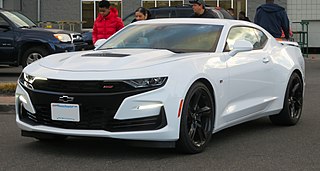
The Chevrolet Camaro is a mid-size American automobile manufactured by Chevrolet, classified as a pony car. It first went on sale on September 29, 1966, for the 1967 model year and was designed to compete with the Ford Mustang. The Camaro shared its platform and major components with the Firebird, produced by General Motors' Pontiac division that was also introduced for 1967.
The GM Ecotec engine, also known by its codename L850, is a family of all-aluminium inline-four engines, displacing between 1.4 and 2.5 litres. Confusingly, the Ecotec name was also applied to both the Buick V6 Engine when used in Holden Vehicles, as well as the final DOHC derivatives of the previous GM Family II engine; the architecture was substantially re-engineered for this new Ecotec application produced since 2000. This engine family replaced the GM Family II engine, the GM 122 engine, the Saab H engine, and the Quad 4 engine. It is manufactured in multiple locations, to include Spring Hill Manufacturing, in Spring Hill, Tennessee, with engine blocks and cylinder heads cast at Saginaw Metal Casting Operations in Saginaw, Michigan.

The Northstar engine is a family of high-performance 90° V engines produced by General Motors between 1993 and 2011. Regarded as GM's most technically complex engine, the original double overhead cam, four valve per cylinder, aluminum block/aluminum head V8 design was developed by Oldsmobile R&D, but is most associated with Cadillac's Northstar series.

The GMC Envoy is a mid-size SUV manufactured and marketed by General Motors for the 1998 to 2009 model years over two generations. Adopting a nameplate used by GM Canada, the Envoy was a rebadged variant of the Chevrolet TrailBlazer, Oldsmobile Bravada, Buick Rainier, Isuzu Ascender, and Saab 9-7X.
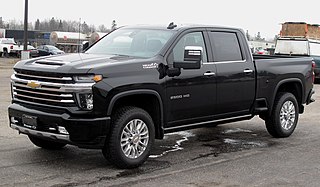
The Chevrolet Silverado is a range of trucks manufactured by General Motors under the Chevrolet brand. Introduced for the 1999 model year, the Silverado is the successor to the long-running Chevrolet C/K model line. Taking its name from the top trim level from the Chevrolet C/K series, the Silverado is offered as a series of full-size pickup trucks, chassis cab trucks, and medium-duty trucks. The fourth generation of the model line was introduced for the 2019 model year.

The General Motors LS-based small-block engines are a family of V8 and V6 engines designed and manufactured by American automotive company General Motors. First introduced in 1997, the family is a continuation of the earlier first- and second-generation Chevrolet small-block engine, of which over 100 million have been produced altogether, and is also considered to be one of the most popular V8 engines ever. Spanning three generations, a new, sixth generation is expected to enter production soon. Various small-block V8s were and still are available as crate engines.
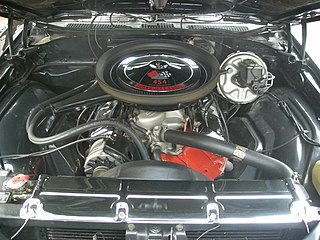
The Chevrolet "big block" engine is a term for a series of large-displacement, naturally-aspirated, 90°, overhead valve, gasoline-powered, V8 engines; that were developed and produced by the Chevrolet Division of General Motors, from the 1950s until present.

The Chevrolet small-block engine is a series of gasoline-powered V8 automobile engines, produced by the Chevrolet division of General Motors between 1954 and 2003, using the same basic engine block. Referred to as a "small-block" for its size relative to the physically much larger Chevrolet big-block engines, the small-block family spanned from 262 cu in (4.3 L) to 400 cu in (6.6 L) in displacement. Engineer Ed Cole is credited with leading the design for this engine. The engine block and cylinder heads were cast at Saginaw Metal Casting Operations in Saginaw, Michigan.

The Iron Duke engine is a 151 cu in (2.5 L) straight-4 piston engine built by the Pontiac Motor Division of General Motors from 1977 until 1993. Originally developed as Pontiac's new economy car engine, it was used in a wide variety of vehicles across GM's lineup in the 1980s as well as supplied to American Motors Corporation (AMC). The engine was engineered for fuel efficiency, smooth operation, and long life, not for performance. Total Duke engine production is estimated to be between 3.8 and 4.2 million units.
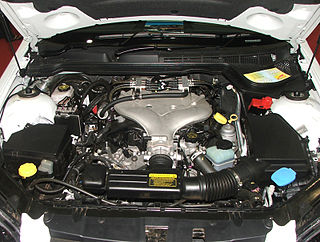
The GM High Feature engine is a family of modern DOHC V6 engines produced by General Motors. The series was introduced in 2004 with the Cadillac CTS and the Holden Commodore (VZ).

The Buick V6 is an OHV V6 engine developed by the Buick division of General Motors and first introduced in 1962. The engine was originally 198 cu in (3.2 L) and was marketed as the Fireball engine. GM continued to develop and refine the 3.8 L (230 cu in) V6, eventually and commonly referred to simply as the 3800, through numerous iterations.

The High Value engine family from General Motors is a group of cam-in-block or overhead valve V6 engines. These engines feature cast iron blocks and aluminum heads, and use the same 60° vee bank as the 60° V6 family they are based on, but the new 99 mm (3.90 in) bore required offsetting the bores by 1.5 mm (0.059 in) away from the engine center line. These engines are the first cam-in-block engines to implement variable valve timing, and won the 2006 Breakthrough Award from Popular Mechanics for this innovation. For the 2007 model year, the 3900 engine featured optional displacement on demand or "Active Fuel Management" which deactivates a bank of cylinders under light load to increase highway fuel economy. It was rumored that GM would produce a 3-valve design, but that never came to be. These engines were produced primarily at the GM factory in Tonawanda, New York, and at the Ramos Arizpe engine plant in Mexico. The assembly line for this engine was manufactured by Hirata Corporation at its powertrain facility in Kumamoto, Japan.

The Buick V8 is a family of V8 engines produced by the Buick division of General Motors (GM) between 1953 and 1981. All were naturally aspirated OHV pushrod engines.
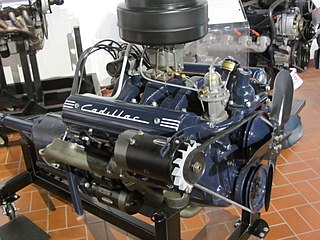
The term Cadillac V8 may refer to any of a number of V8 engines produced by the Cadillac Division of General Motors since it pioneered the first such mass-produced engine in 1914.
Variable displacement is an automobile engine technology that allows the engine displacement to change, usually by deactivating cylinders, for improved fuel economy. The technology is primarily used in large, multi-cylinder engines. Many automobile manufacturers have adopted this technology as of 2005, although the concept has existed for some time prior to this.

The fifth-generation Chevrolet Camaro is a pony car that was manufactured by American automobile manufacturer Chevrolet from 2010 to 2015 model years. It is the fifth distinct generation of the muscle/pony car to be produced since its original introduction in 1967. Production of the fifth generation model began on March 16, 2009 after several years on hiatus since the previous generation's production ended in 2002 and went on sale to the public in April 2009 for the 2010 model year.

The Chevrolet 90° V6 family of V6 engines began in 1978 with the Chevrolet 200 cu in (3.3 L) as the base engine for the all new 1978 Chevrolet Malibu. The original engine family was phased out in early 2014, with its final use as the 4.3 L (262 cu in) V6 engine used in Chevrolet and GMC trucks and vans. Its phaseout marks the end of an era of Chevrolet small-block engine designs dating back to the 1955 model year. A new Generation V 4.3 L (262 cu in) V6 variant entered production in late 2013, based on the LT1 small block V8 and first used in the 2014 Silverado/Sierra 1500 trucks.

The 1955 Chevrolet is an automobile which was introduced by Chevrolet in Autumn 1954 for the 1955 model year. It is considered a huge turning point for the manufacturer and a major success. It was available in three models: the 150, 210, and Bel Air.
The GM L3B engine is a turbocharged four-cylinder gasoline engine designed by General Motors. It is an undersquare aluminum DOHC inline-four displacing 2.7 liters and tuned for strong low-end torque.
References
- ↑ Stabinsky, Mark; Albertson, William; Tuttle, Jim; Kehr, David; Westbrook, James; Karbstein, Henning; Kuhl, Mario (April 16, 2007). "Active Fuel Management Technology: Hardware Development on a 2007 GM 3.9L V-6 OHV SI Engine" – via www.sae.org.
- ↑ "General Motors Active Fuel Management Cylinder Deactivation Technology". GM Authority.
- ↑ 2010 Chevrolet Camaro Details and Hi-Res Photos
- ↑ "'19 Silverado may emerge as efficiency leader". Archived from the original on 2018-04-26. Retrieved 2018-02-21.
- ↑ "Introducing the All-New 2019 Chevrolet Silverado". Archived from the original on 2018-04-26. Retrieved 2018-02-21.
- ↑ Wilcutts, Mark; Switkes, Joshua; Shost, Mark; Tripathi, Adya (April 8, 2013). "Design and Benefits of Dynamic Skip Fire Strategies for Cylinder Deactivated Engines". SAE International Journal of Engines. 6 (1): 278–288. doi:10.4271/2013-01-0359 – via www.sae.org.
- ↑ "GM adopts advanced cylinder deactivation for 2019 Chevy Silverado V8s".
- ↑ "2019 Winner: Chevy Silverado 6.2L OHV V-8 with DFM".